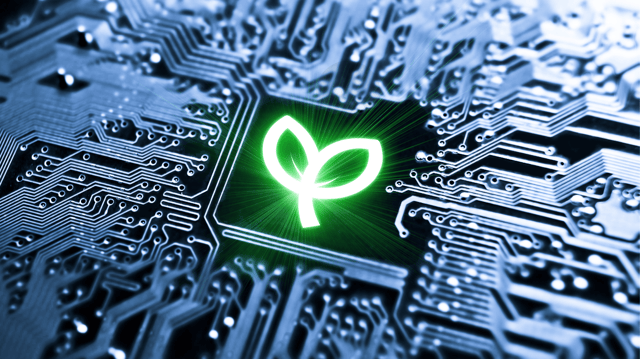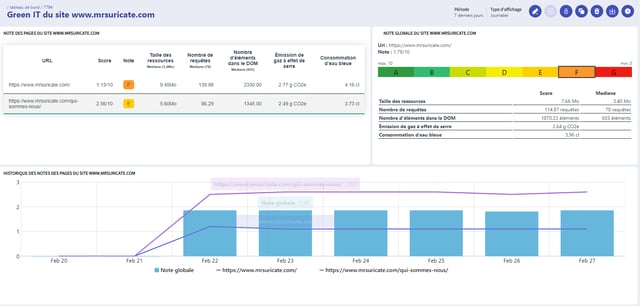Green IT in software development - What you need to know
Reducing emissions is a growing priority for many countries and industries, and IT is no exception.
In this article, we'll focus on the role of Green IT not only in the creation of sustainable web and mobile applications, but also in the success of businesses that need to face up to ecological challenges with ingenuity in order to stay relevant and increase their efficiency on many levels.

What is Green IT?
Green IT refers to more environmentally-friendly computing practices, aimed above all at minimizing the energy consumption of our digital tools and software.
To take things a step further, there are two types of digital use:
- On-site, local use of your computers and servers.
- The use of Web services, "Cloud", which operate via remote servers.
Even though digitized products may seem far less polluting than tangible ones, numerous studies show the extent to which the digital world contributes to GHG emissions, which is far from negligible!
According to a study by Frédéric Bourdage, expert in digital sobriety and founder of the GreenIT.fr website, it is estimated that the carbon footprint linked to digital activities represents around 5% of total global emissions, or around 2 gigatonnes of CO2.
According to the pre-report of the Senate's information mission on the environmental footprint of the digital sector, digital GHG emissions could increase significantly if nothing is done to reduce their footprint: +60% by 2040, or 6.7% of national GHG emissions.
Digital emissions break down as follows (according to a study by Think Tank Green IT):
- User equipment (66%)
- Networks (19%)
- Computer centers (15%)
When it comes to software development, Green IT focuses on reducing emissions by lightening the load on networks and data centers.
The fundamental principles of Green IT in software development
In practice, Green IT in 2024 generally translates into the following strategies:
Economical code writing
One of the key elements of Green IT is writing energy-efficient code, minimizing the resources needed to run software applications.
By optimizing algorithms and reducing computational complexity, developers can create a digital product that consumes less energy and generates less heat, thus contributing to a smaller carbon footprint.
In addition, minimizing the use of memory-intensive processes and eliminating redundant code can further improve energy efficiency.

Internal infrastructure reduction
Cloud service providers often have a highly optimized infrastructure in terms of energy consumption.
By migrating to cloud-based services, companies can minimize their in-house infrastructure needs while benefiting from energy efficiency and sustainable practices.
This not only minimizes the cost and complexity of infrastructure management, but also allows you to benefit from the energy efficiency and sustainable practices of these datacenters. For example, our partner DRI offers eco-responsible web hosting, thanks to its innovative ecological datacenter in France, with a PUE of 1.15.
Test automation / Green IT testing
Testing tools are another eco-friendly practice which, not only is eco-friendly in itself by identifying bugs in the most efficient way possible, but can also help identify where your software solutions can be improved from an environmental point of view through automated Green IT testing.
Automated testing offers several advantages in terms of digital sustainability:
Product lifecycle optimization: by detecting and correcting bugs more quickly, organizations reduce the waste of resources associated with fixing defects at advanced stages of development.
Reduced carbon emissions: manual testing requires extensive hardware and energy infrastructure. Automated testing enables companies to significantly reduce their energy consumption and, consequently, their carbon emissions.
Measure the state of your software and development practices to identify areas for improvement: regular Green IT testing can provide vital information on the current state of your digital infrastructure, as well as the success of Green IT initiatives, so you can fine-tune your strategies over time.
Green IT monitoring
Green IT monitoring consists of carrying out Green IT tests on an ongoing basis. By tracking the digital footprint over time, we are constantly aware of areas for improvement.
It's possible to achieve more favorable results before an ecologically ineffective update, and to be unaware of the problem until it creates damage.
For example, at Mr SuricateGreen IT monitoring provides you with the following key KPIs:
- Resource size
- The number of requests
- The number of elements in the DOM
- Greenhouse gas emissions
- Water consumption

The benefits of Green IT practices for businesses
Green IT is not only good for the environment, but also for many other aspects of business:
Lower operating costs
Companies can significantly reduce their energy consumption and associated costs by adopting a greener infrastructure.
According to a study carried out by Boavizta, an association dedicated to assessing the environmental impact of digital technology, of the organizations that see savings thanks to Green IT practices, one in three cite reduced IT purchases, and less than one in four cite reduced energy bills.
In the study, games publisher Ubisoft mentions a potential saving "in excess of €1 million per year by putting workstations on standby and extending equipment lifespan".
Risk mitigation
Following sustainable practices helps companies comply with environmental regulations and avoid potential fines or legal problems.
It also reduces the likelihood of negative publicity...
An opportunity to stand out from the competition
By adopting sustainable practices associated with Green IT, companies can position themselves as players in the green industry, fostering a positive image that attracts customers and partners who increasingly favor eco-responsibility.
One way of promoting Green IT initiatives is through case studies and success stories highlighting the concrete environmental benefits of the projects carried out.
A development process focused on efficiency
Sustainable practices drive innovation as companies seek new ways to optimize processes and reduce waste, which inevitably leads to the development of more efficient software solutions.
Mr Suricate - French leader in no-code automated testing
By reducing resource consumption, optimizing product lifecycles and cutting carbon emissions through Green IT strategies and practices, companies can integrate digital sustainability into their software development practices.
When it comes to Green IT, test automation is an indispensable practice, and we at Mr Suricatewe cover a wide range of automated tests, so that you can control your acceptance testing and offer your users the best possible experience.



.png)
